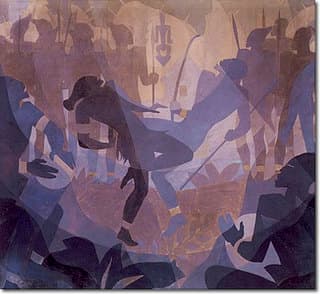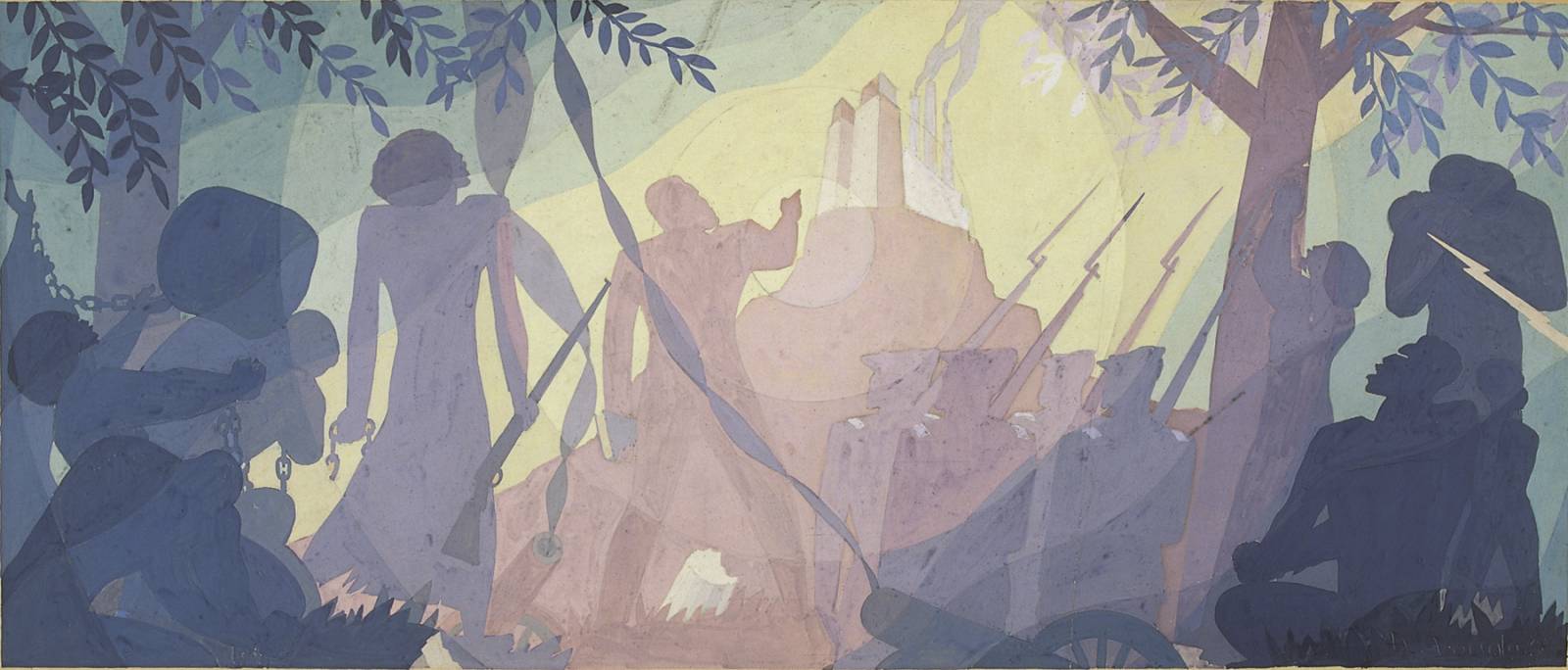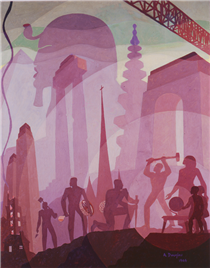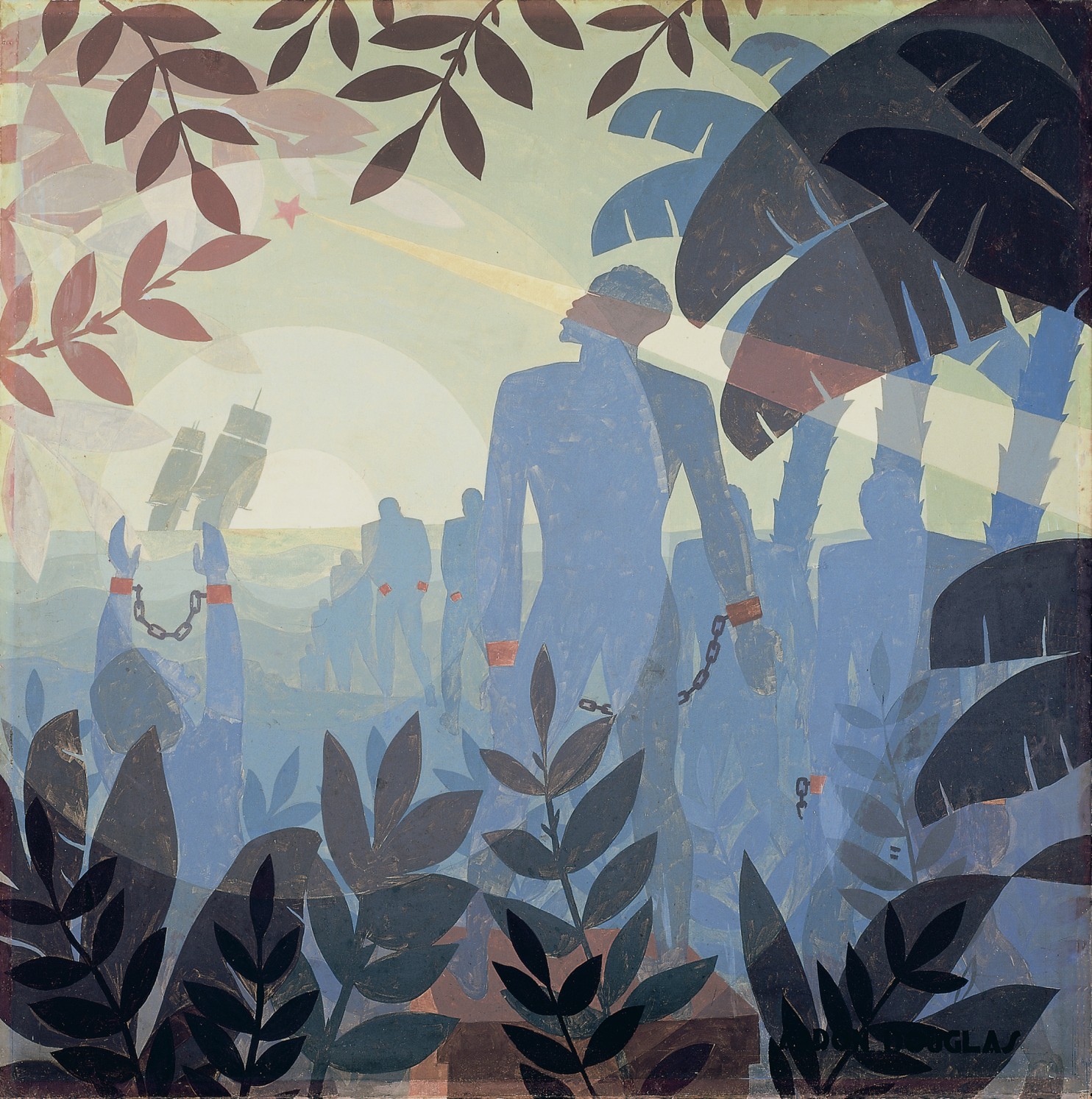In art from the University of Nebraska. Aaron Douglas was the most prominent African-American artist of the Harlem Renaissance movement of the 1920s.

How Artist Aaron Douglas Put Music Into His Murals Interlude
In 1934 Douglas was commissioned to create a series of four murals for the 135th Street branch of the New York Public Library funded by the Works Progress Administration Federal Art Project.

. Another significant figure in the Harlem Renaissance is known as one of the most comprehensive artists of the era. Noahs Ark Aaron Douglas 1927. Aaron Douglas May 26 1899 February 3 1979 was an American painter illustrator and visual arts educator.
See more paintings by Aaron Douglas on our website here. The Gray Tree is one of Mondrians most famous works and an important painting with regard to the development of his career as it exemplifies his early transition toward abstraction and his application of Cubist principles to represent landscape. One of Douglas most famous paintings is actually a large mural that exists at the New York Public Library and was commissioned under President Franklin Delano Roosevelts Works Progress Administration.
He is best known for his silhouette paintings of which Aspiration 1936 held by the de Young Museum in San Francisco is his most famous. The crucifixion scene that is depicted in the painting shows several elements that constitute Douglas art. He was a significant figure in the Harlem Renaissance.
The series was titled Aspects of Negro Life and the four murals include The Negro In An African Setting An Idyll of the Deep South From Slavery Through Reconstruction and Song of the. It was published in James Weldon Johnson s Gods Trombones in 1927. He was later dubbed the father of Black American art.
For subject matter Douglas drew on the history of the African American experience from enslavement through the Reconstruction to twentieth-century lynching and. Into Bondage 1936 From Slavery through Reconstruction 1934. Some of his most famous illustration projects include his images for James Weldon Johnsons poetic work Gods Trombone 1927 and Paul Morands Black Magic 1929.
What was Aaron Douglas most famous painting. He was not only a painter but also an illustrator and an educator of arts. After receiving a fellowship from the Barnes Foundation in Pennsylvania he took time to study African and.
He was a major figure in the Harlem RenaissanceHe developed his art career painting murals and creating illustrations that addressed social issues around race and segregation in the United States by utilizing African-centric imagery. Born in Kansas Aaron Douglas received a BFA. He has been dubbed father of African-American art Born in 1899 in Topeka Kansas Douglas gained an appreciation for life through various jobs early in his life.
In 1934 with funding from the Public Works Administration Aaron Douglas painted his best-known set of murals Aspects of Negro Life for the Countee Cullen branch of the New York Public Library. In addition to his illustration work Douglas explored educational opportunities. Aaron Douglas was the most prominent artist-illustrator of the Harlem Renaissance a movement of the 1920s during which African Americans developed a unique artistic style.
The Gray Tree is one of Mondrians most famous works and an important painting with regard to the development of his career as it exemplifies his early transition toward abstraction and his application of Cubist principles to represent landscape. 19351939 Metropolitan Museum of Art and The Judgment Day1939 National Gallery of. History is filled with countless valuable contributions of African Americans among them is the preeminent artist Aaron Douglas.
Carl van Vechten Aaron Douglas April 10 1933 photograph Yale Collection of American Literature Beinecke Rare Book and Manuscript Library Yale University. A modernist style painter he was dubbed the Father of African-American Art. Some of his most famous illustration projects include his images for James Weldon Johnsons poetic work Gods Trombone 1927 and Paul Morands Black Magic 1929.
The two paintings Let My People Goca. Gods Trombone Aaron Douglas 1927. He taught in Kansas City schools for a few years and then began to study with Winold Reiss an illustrator from Germany who encouraged him to look to African art for inspiration in his work.
Douglas created some of his best-known painting in the 1930s. His most famous work is a series of murals in four panels each depicting a different part of the African-American history and lifestyle. In addition to his illustration work Douglas explored educational opportunities.
One of Aaron Douglas s most popular paintings is The Crucifixion 1. His first major commission to illustrate Alain LeRoy. He built up his craft profession by painting wall paintings and making representations that tended to social issues around race and isolation in the United States by using African-driven symbolism.
Clear-cut delineation change of shadows and light stylized human bodies and geometric figures as concentric circles in. Seven Negro Sermons in VerseThe seventh panel in the series Let My People Go visually interprets the Old Testament story about Gods order to Moses to lead. An Idyll of the Deep South Aaron Douglas 1934.
His works are a blend of Art Deco and elements of Egyptian wall paintings. He held a distinctive position as a prominent figure in the Harlem Renaissance that explored the cultural. A leading Harlem Renaissance painter Douglas artistic interests in modernism and African art fueled his artistic style.
New York and Washington DCThe Metropolitan Museum of Art and the National Gallery of Art have each acquired a significant work by the leading visual artist of the Harlem Renaissance Aaron Douglas American 18991979. Famous Paintings In Museums - 14 images - 35 museums ideas in 2021 art museum homeschool art art imb009 examples of museum collection by famous artist step inside famous paintings at indiana museum s new art. It was then that he created one of his most legendary works a series of murals entitled Aspects of Negro Life that featured four panels each depicting a different part of the African-American experience.
He was famous for his paintings that depicted the African culture. Aaron Douglas was an African American painter and graphic artist who played a leading role in the Harlem Renaissance of the 1920s and 1930s. Charleston Aaron Douglas 1928.
National Gallery of Art. The Crucifixtion Aaron Douglas 1927. This radiant painting in lavender and yellow-gold hues belongs to a series of eight panels that revisits designs Aaron Douglas made in 1926 to illustrate author and activist James Weldon Johnsons Gods Trombones.
Born in Topeka Kansas young Aaron developed an interest in art early on. Douglas created some of his best-known painting in the 1930s. After receiving a fellowship from the Barnes Foundation in Pennsylvania he took time to study African and.
Aaron Douglas was an American painter artist and visual expressions teacher. Aaron Douglas Painter Muralist BFA in Art 1922. Congo Aaron Douglas 1928.

How Artist Aaron Douglas Put Music Into His Murals Interlude

Celebrate Black History Month And See Aaron Douglas S Aspiration De Young

Aaron Douglas 17 Artworks Painting

Aaron Douglas Major Artist Of The Harlem Renaissance Kentake Page

Artist Of The Month Aaron Douglas Muddy Colors

Artist Of The Month Aaron Douglas Muddy Colors
Aaron Douglas Let My People Go The Metropolitan Museum Of Art

0 comments
Post a Comment